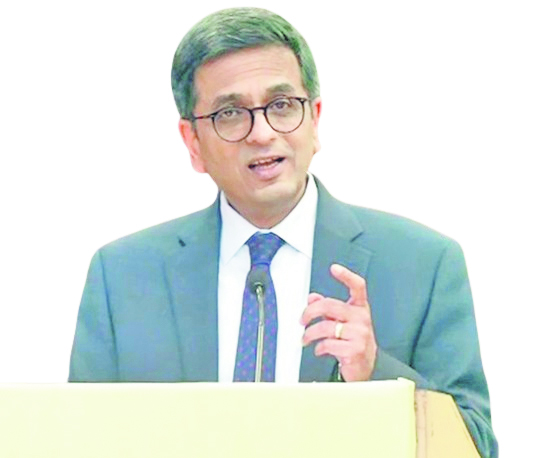Chief Justice of India DY Chandrachud on Sunday said he is ready to begin a conversation on the controversial issue of higher courts going on long vacations.
Each year, the Supreme Court goes on over a month-long vacation during the peak summer season. It also takes Christmas/winter break for around two weeks. Besides, the top court closes for a week each during Dussehra and Diwali.
During the summer vacations, the Supreme Court keeps open one or two benches open for hearing urgent and important matters.
“Let us begin the conversation on long vacations and whether alternatives such as flexitime for lawyers and judges is possible,” said the CJI.
There has been a controversy about the long vacation in higher judiciary and it has triggered criticisms of pendency. In 2022, former Law Minister Kiren Rijiju reportedly criticised the long vacations of the court and the inconvenience it caused to litigants.
Last year, a Parliamentary panel called for doing away with long vacations in the Supreme Court and the High Courts.
Vacation is a time for judges to write judgments, research, do administrative work, prepare for cases for hearings, and travel.
The remarks of the CJI came at an event as the Supreme Court of India celebrated its diamond jubilee year.
Speaking at an event to mark the 75th Foundation Day of the Supreme Court, the CJI also said that we must emerge out of the adjournment culture to a culture of professionalism.
The legal profession must provide a level playing field for first-generation lawyers – men, women and others from marginalised segments who have the will to work and the potential to succeed, he added.
CJI Chandrachud said that the 75th year since the founding provides an opportunity to meet these challenges and step into the future with an honest assessment of our progress.
“We must reflect on the journey that we have traversed and renew our pledge to uphold the Constitution within and beyond the courtrooms,” he added.
Speaking at the event, also attended by Prime Minister Narendra Modi, CJI said that our decisions both in the judicial and administrative realms, have been aimed at enhancing accessibility to the Indian judicial system for common citizens.
CJI said that through its judgments, the Supreme Court has enhanced the rights of citizens by diluting the standards of locus standi and by recognising a set of new rights under Article 21 of the Constitution, such as the right to a speedy trial.
“On the administrative side, the Supreme Court has been identifying and eliminating as many barriers to justice– unequal access to legal resources, unfamiliarity of the English language, issues of physical accessibility of courts– in order to create procedural fairness,” he added.
Justice Chandrachud said, “Today is not only a celebration of that one day when the Supreme Court came into being, but it also is a celebration of the decades’ worth of hard work by succeeding generations of judges and lawyers that went into making this a ‘people’s court’.”
In celebrating the history of this day, we must look back and look forward in equal measure, he said.
Supreme Court has enabled ‘Futuristic Court Technology’ in three courtrooms and soon other courtrooms shall be equipped with such technology, CJI announced.
“This technology facilitates paperless proceedings, a comprehensive digital library for the bench and the advocates, state-of-the-art video conferencing, large video walls, smart monitors and document visualisers, all of which redefine the courtroom experience,” said the CJI.
He further announced that the Supreme Court is soon going to migrate its digital data to a safe, secure and sovereign cloud.
“This would be a shot in the arm for the IT setup of the Court. Cloud storage would ensure privacy, integrity, high availability, and secure accessibility of the Supreme Court’s domain data. We are also on the verge of opening a War Room equipped with technology that would enable the Supreme Court to monitor judicial data of the entire country in real-time by using the National Judicial Data Grid (NJDG) and Juris, both of which are information-sharing platforms for the district judiciary.
Summarising the achievements of the Supreme Court, CJI also said that nearly 1,28,000 e-filings have been done so far, with a consistent rise in the share of e-filings compared to physical filings.
Even after the pandemic, hybrid hearings continue to be a feature of our courts, said the CJI, adding, that is, any Indian lawyer sitting in any part of the country, or the world can argue before this Court through video conferencing.
Hybrid hearings have democratised access to the Supreme Court and opened the space for those who were unable to approach the Supreme Court due to physical distance, he added.
Till now, we have dealt with over 5 lakh cases through hybrid hearings. The live proceedings of the Supreme Court Constitutional Bench hearings are popular and speak to the genuine curiosity that people have towards our courts and procedures, Justice Chandrachud said.
Further, the Supreme Court of India today operates in a nearly complete paperless mode, with almost all benches using digitised paper books.
“Judges are provided with scanned, bookmarked, and digitally signed case records which they access, read, annotate and preserve for their reference at their residence and in Courtrooms. More than 13 lakh legacy and live case records with approximately 10 crore pages have been digitised,” said the CJI.
Just as we make our courts tech-savvy, we must also realise that India is going through a period of social and demographic transformation, said the CJI, adding that anyone who visits India will notice a striking feature of the changing demographics.
“Now, women can be seen in important positions. There is a focus on greater inclusion of the marginalised sections of society. Equally inspiring is the confidence of the younger population to succeed in their professional lives,” Justice Chandrachud said.
He also said that before the beginning of 2024, only 12 women were designated as ‘senior advocates’ in the history of the Supreme Court over the last 74 years, however, last week, the Supreme Court designated 11 women coming from different parts of the country, as senior advocates at one selection.




